Fatigue Characteristics of Fe-Based Shape-Memory Alloys
Abstract
1. Introduction
2. Materials
2.1. Production of Fe-SMAs
2.2. Mechanical Properties of Fe–SMAs
2.3. Recovery Stress of Fe–SMAs
3. Experimental Program
3.1. Test Specimen
3.2. Test Setup
4. Result and Discussion
4.1. Test Result
4.2. Stress–Strain Response during Cyclic Loading
4.3. Relationship between Stress Range and Number of Cycles
5. Conclusions
- As a result of the fatigue test at a stress ratio of zero of A-type and B-type alloys, fatigue fracture occurred in a stress range between 450 MPa and 475 MPa for A-type alloy and between 375 MPa and 400 MPa for B-type alloy;
- In a large stress range above the yield strength, the maximum strain of both the A-type and B-type alloys tends to increase as the number of loading cycles increases due to cumulative damage. In a relatively small stress range, as the residual strain of the Fe-SMA produced in the hot rolling process recovers, the maximum strain tends to decrease as the number of loading cycles increases;
- Through a first order regression analysis of the test results, the fatigue limits of the A-type and B-type alloys were determined as 473 MPa and 330 MPa, respectively.
Author Contributions
Funding
Acknowledgments
Conflicts of Interest
References
- Lee, W.; Weber, B.; Leinenbach, C. Recovery stress formation in a restrained Fe–Mn–Si-based shape memory alloy used for prestressing or mechanical joining. Constr. Build. Mater. 2015, 95, 600–610. [Google Scholar] [CrossRef]
- Kim, H. Pullout Behavior of Shape Memory Alloy Fiber Embedded in Mortar Matrices. Master’s Thesis, Sejong University, Seoul, Korea, 2015. [Google Scholar]
- Chaudhari, R.; Vora, J.J.; Patel, V.; De Lacalle, L.N.L.; Parikh, D.M. Surface Analysis of Wire-Electrical-Discharge-Machining-Processed Shape-Memory Alloys. Materials 2020, 13, 530. [Google Scholar] [CrossRef]
- Janke, L.; Czaderski, C.; Motavalli, M.; Ruth, J. Applications of shape memory alloys in civil engineering structures—Overview, limits and new ideas. Mater. Struct. 2005, 38, 578–592. [Google Scholar] [CrossRef]
- Czaderski, C.; Shahverdi, M.; Brönnimann, R.; Leinenbach, C.; Motavalli, M. Feasibility of iron-based shape memory alloy strips for prestressed strengthening of concrete structures. Constr. Build. Mater. 2014, 56, 94–105. [Google Scholar] [CrossRef]
- Sato, A.; Chishima, E.; Soma, K.; Mori, T. Shape memory effect in γ⇄ϵ transformation in Fe-30Mn-1Si alloy single crystals. Acta Met. 1982, 30, 1177–1183. [Google Scholar] [CrossRef]
- Shahverdi, M.; Czaderski, C.; Motavalli, M. Iron-based shape memory alloys for prestressed near-surface mounted strengthening of reinforced concrete beams. Constr. Build. Mater. 2016, 112, 28–38. [Google Scholar] [CrossRef]
- Rojob, H.; El-Hacha, R. Self-prestressing using iron-based shape memory alloy for flexural strengthening of reinforced concrete beams. ACI Struct. J. 2015, 114, 523–532. [Google Scholar]
- Michels, J.; Shahverdi, M.; Czaderski, C.; El-Hacha, R. Mechanical Performance of Iron-Based Shape-Memory Alloy Ribbed Bars for Concrete Prestressing. ACI Struct. J. 2018, 115, 877–886. [Google Scholar]
- Schranz, B.; Shahverdi, M.; Czaderski, C.; Michels, J.; Vogel, T.; Motavalli, M. Ribbed iron-based shape memory alloy bars for pre-stressed strengthening applications. In Proceedings of the International Association for Bridge and Structural Engineering Stmposium, Guimaraes, Portugal, 27–29 March 2019. [Google Scholar]
- Byun, K.J.; Song, H.W.; Park, S.S.; Lho, B.C. A study on fatigue characteristics of domestic low-relaxtion PS strands. J. Korea Concr. Inst. 1999, 11, 113–119. [Google Scholar]
- Hong, K.-N.; Yeon, Y.-M.; Shim, W.-B.; Kim, D.-H. Recovery Behavior of Fe-Based Shape Memory Alloys under Different Restraints. Appl. Sci. 2020, 10, 3441. [Google Scholar] [CrossRef]
- ASTM A370-19e1. Standard Test Methods and Definitions for Mechanical Testing of Steel Products; ASTM International: West Conshohocken, PA, USA, 2019. [Google Scholar]
- Wang, G.; Peng, H.; Sun, P.; Wang, S.; Wen, Y. Effect of titanium addition on shape memory effect and recovery stress of training-free cast Fe–Mn–Si–Cr–Ni shape memory alloys. Mater. Sci. Eng. A 2016, 657, 339–346. [Google Scholar] [CrossRef]
- Park, S.-J.; Yim, H.J.; Kwak, H.-G. Evaluation of Microcracks in Thermal Damaged Concrete Using Nonlinear Ultrasonic Modulation Technique. J. Korea Concr. Inst. 2012, 24, 651–658. [Google Scholar] [CrossRef][Green Version]
- ISO 12106:2017(en). Metallic Materials-Fatigue Testing-Axial-Strain-Controlled Method; ISO: Geneva, Switzerland, 2017. [Google Scholar]
- Helgason, T.; Hanson, J.M.; Somes, N.F.; Corley, W.G.; Hognestad, E. Fatigue strength of high yield reinforceing bars. In NCHRP Bulletin 164; Transportation Research Board; National Research Council: Washington, DC, USA, 1976. [Google Scholar]
- Macgregor, J.G.; Jhamb, I.C.; Nutall, N. Fatigue strength of hot rolled deformed reinforcing bars. J. Am. Concr. Inst. 1971, 68, 169–179. [Google Scholar]
- Asahi, H.; Yagi, A.; Ueno, M. Effect of ferrite formation on abnormal austenite grain coarsening in low-alloy steels during the hot rolling process. Met. Mater. Trans. A 1998, 29, 1375–1381. [Google Scholar] [CrossRef]
- Han, Y.; Shi, J.; Xu, L.; Cao, W.; Dong, H. TiC precipitation induced effect on microstructure and mechanical properties in low carbon medium manganese steel. Mater. Sci. Eng. A 2011, 530, 643–651. [Google Scholar] [CrossRef]
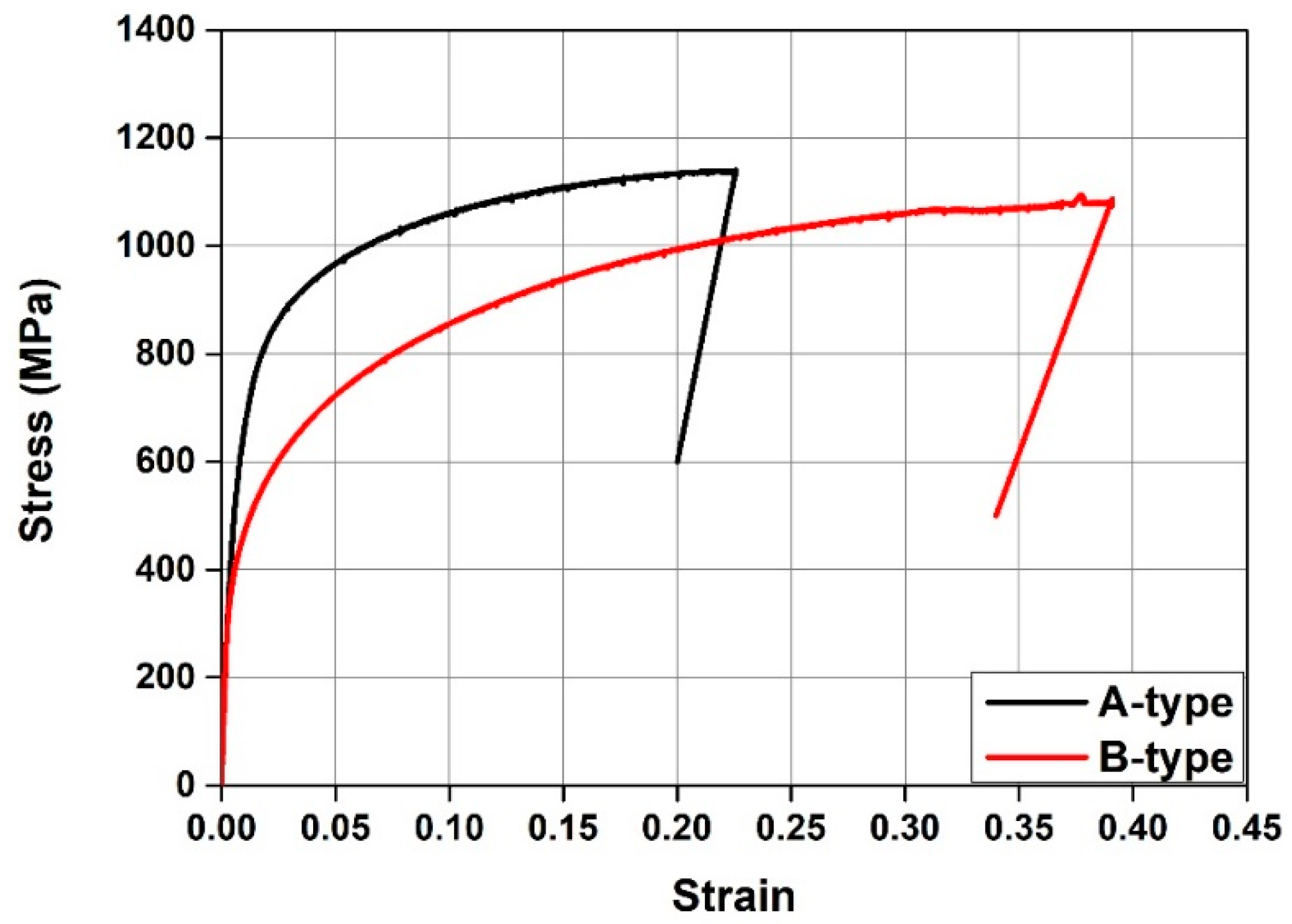
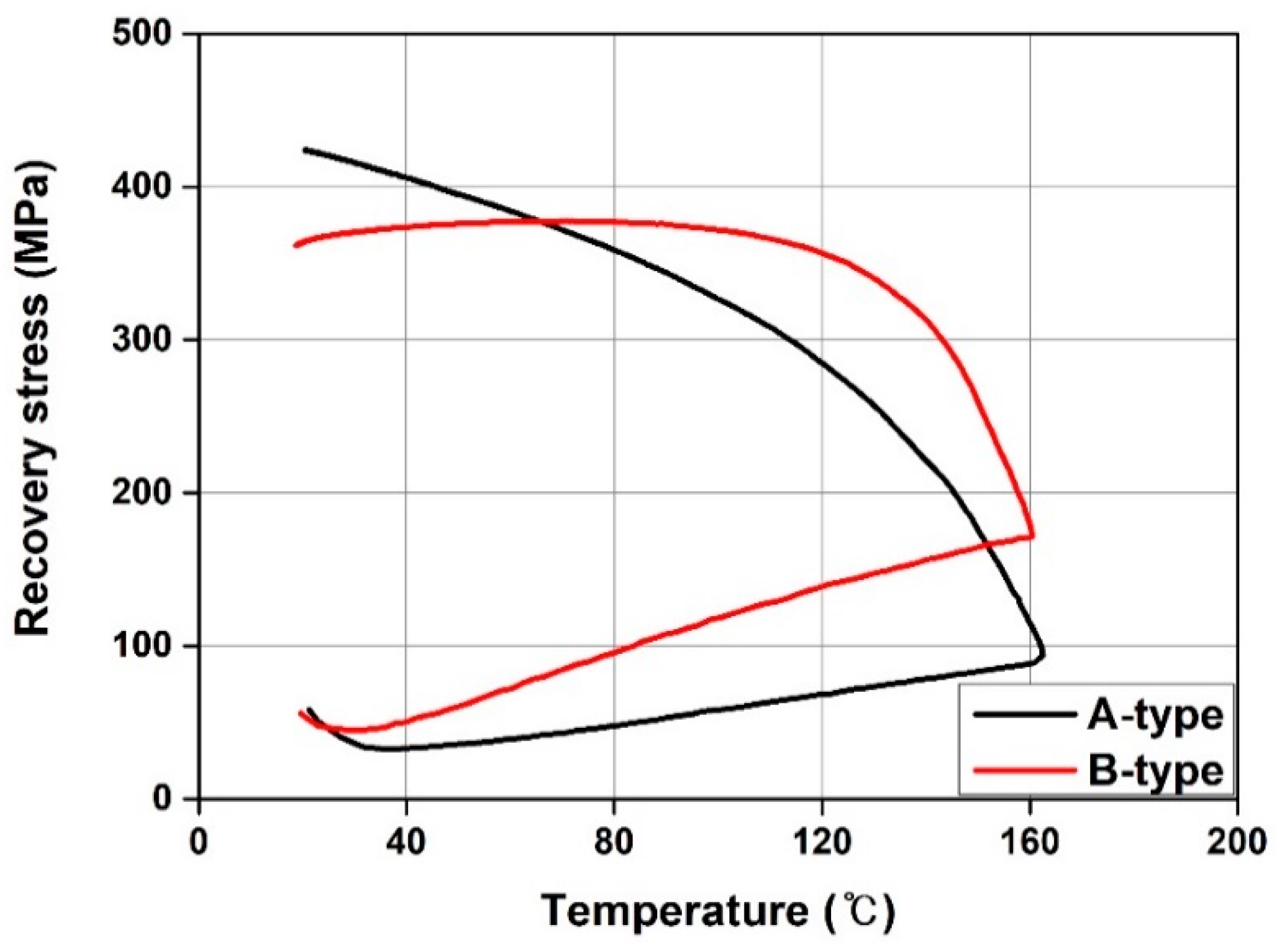
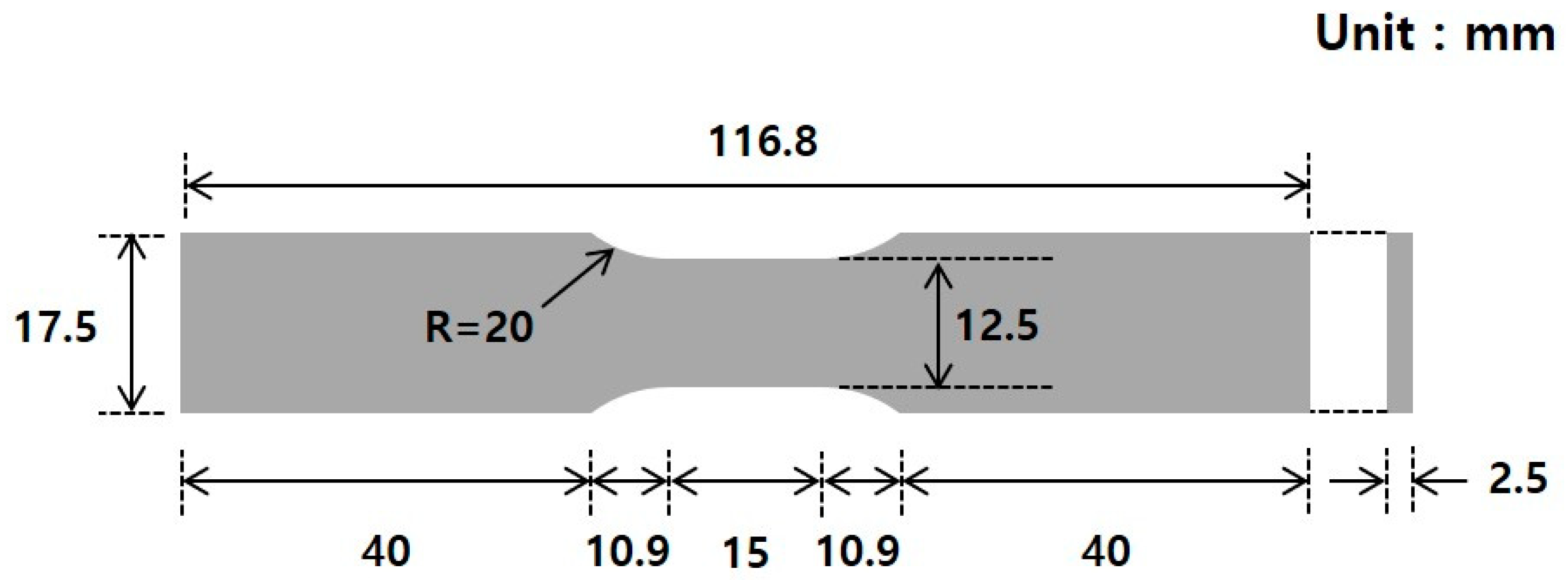
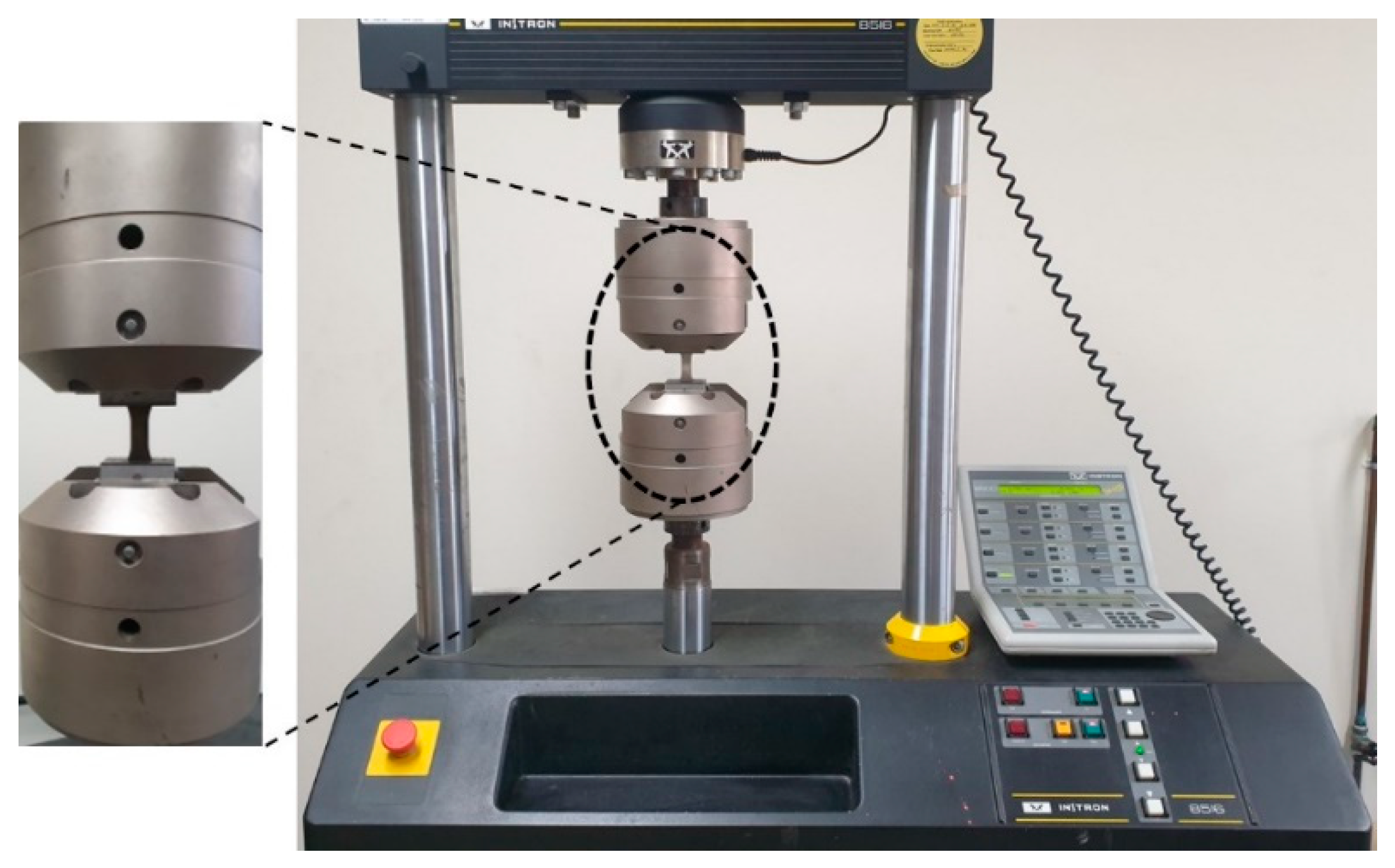

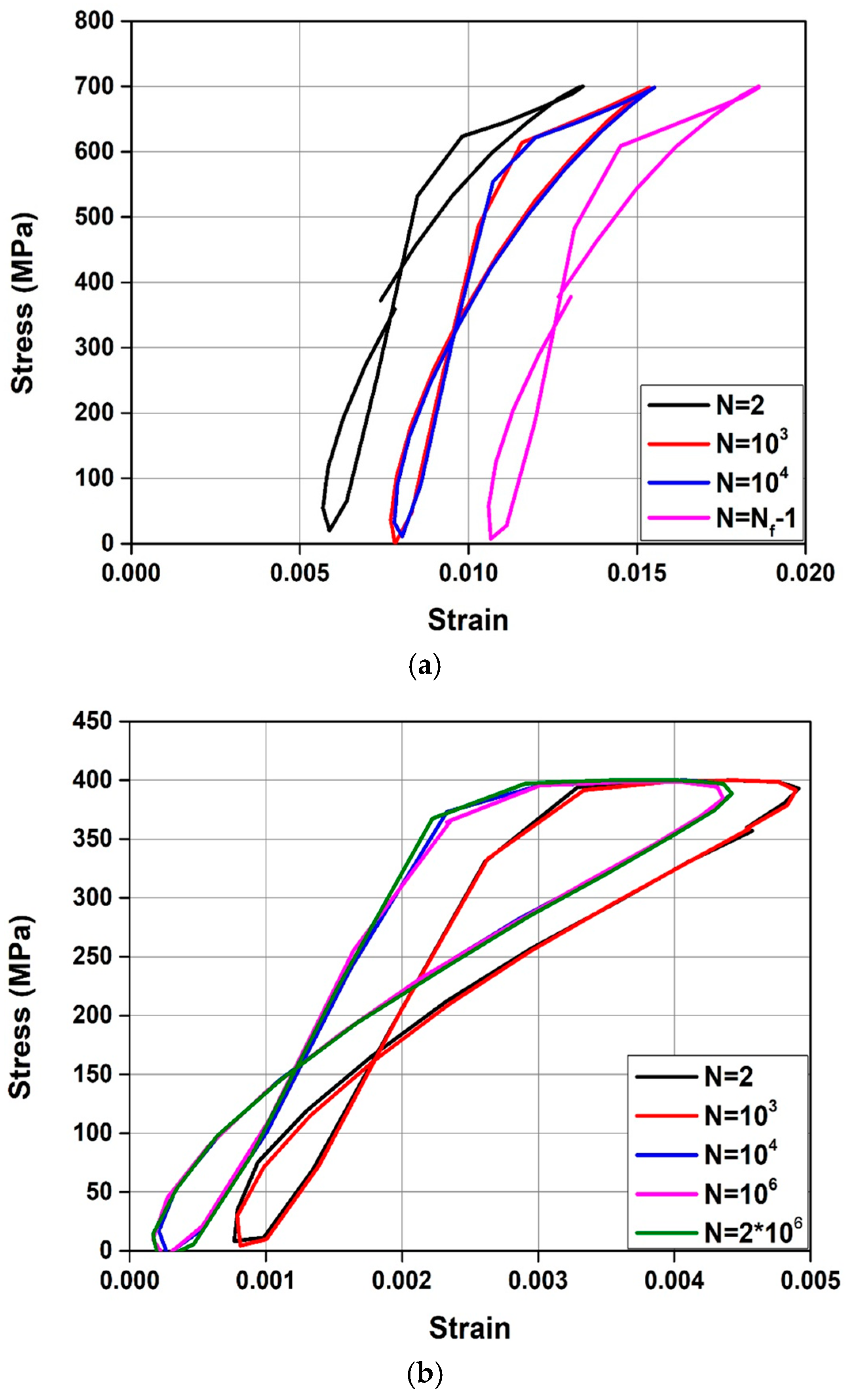
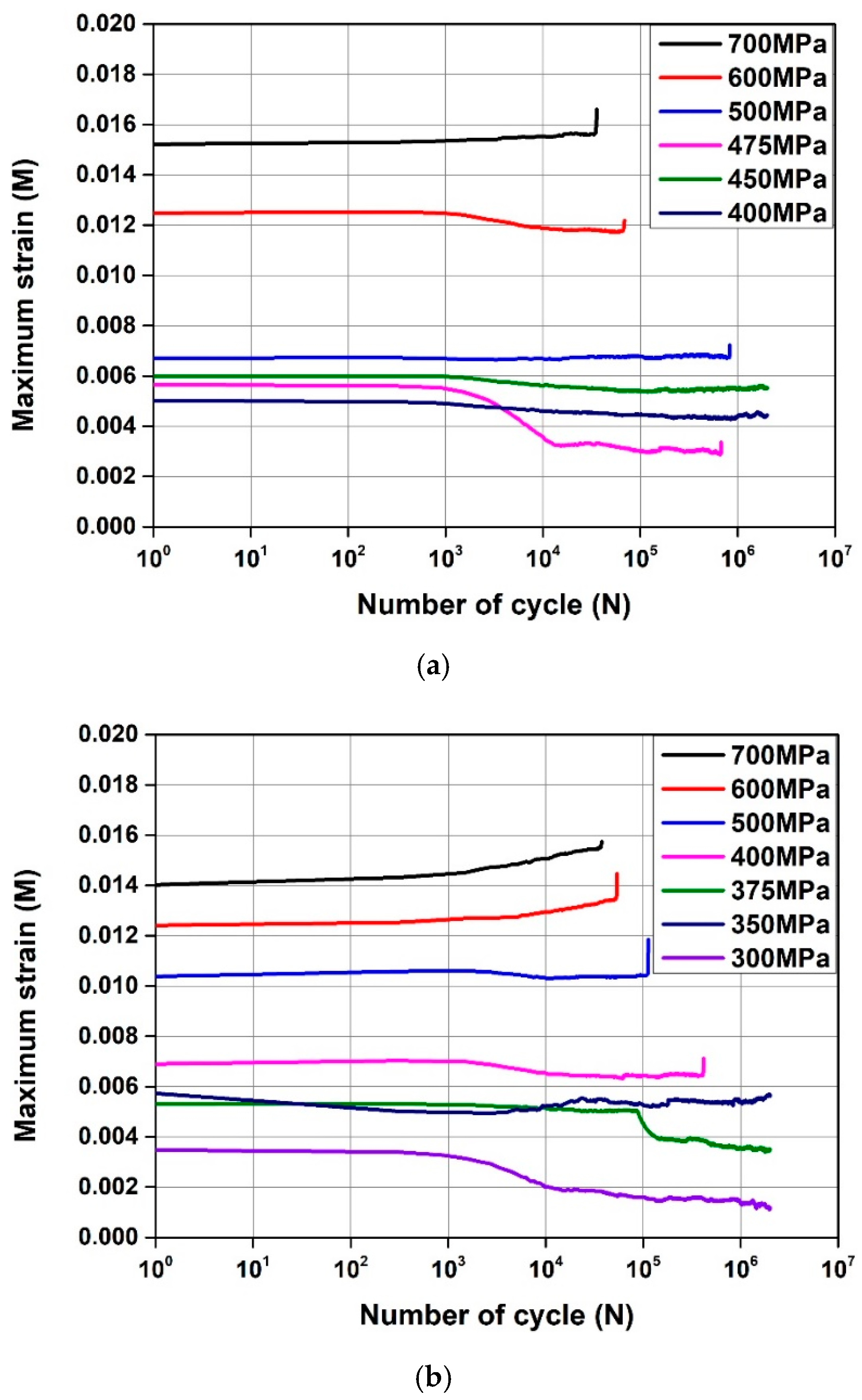

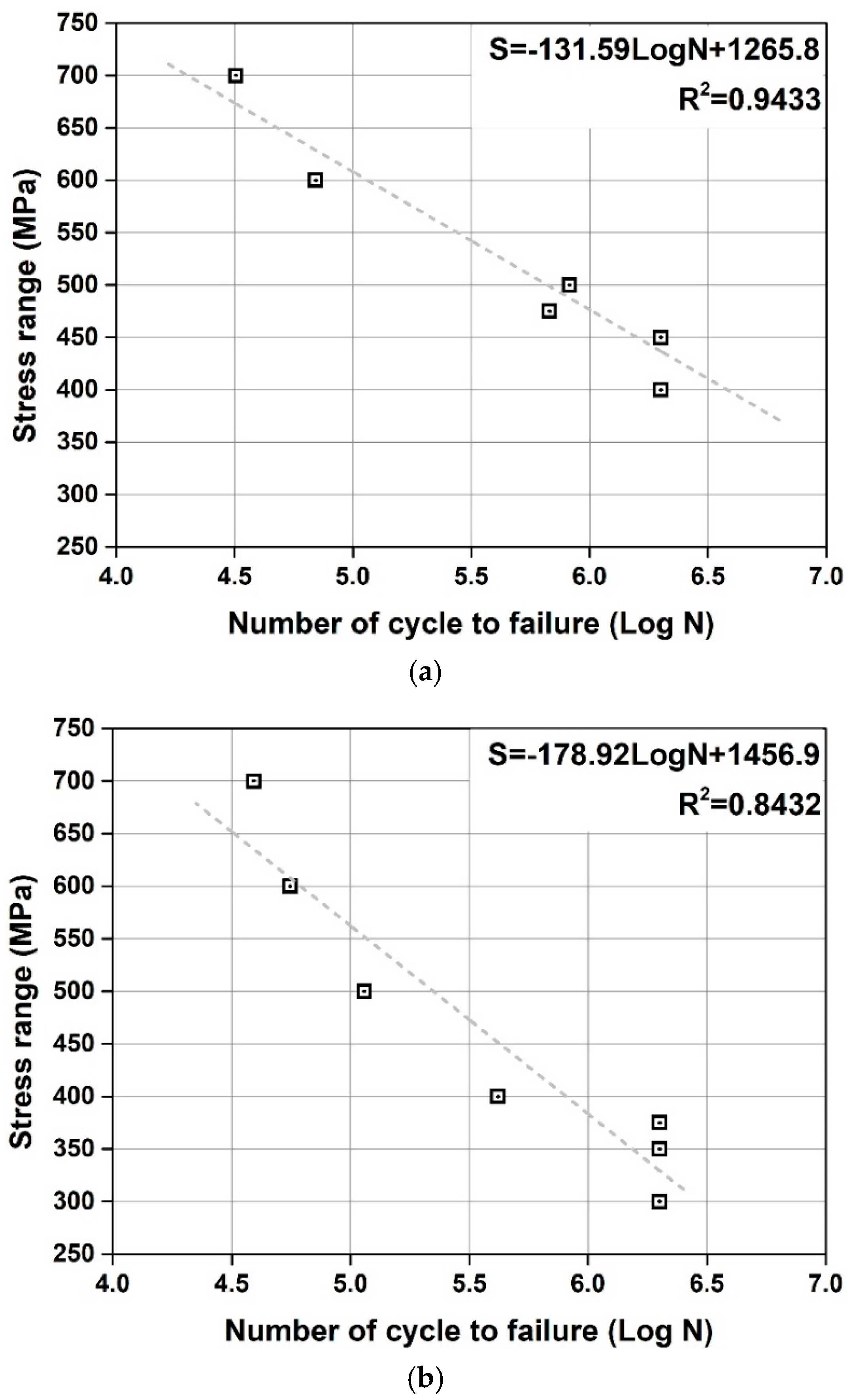
| Type of SMA | Chemical Composition (weight%) | Heat Treatment |
|---|---|---|
| A-type | Fe–17Mn–5Si–5Cr–0.3C–1Ti | Non-heat treatment |
| B-type | Fe–17Mn–5Si–5Cr–4Ni–0.1C | Heat treatment |
| Specimen | Elastic Modulus (GPa) | Yield Strain | Yield Stress (MPa) | Ultimate Strain | Ultimate Stress (MPa) |
|---|---|---|---|---|---|
| A-type | 124.57 | 0.00666 | 599 | 0.22556 | 1140 |
| B-type | 123.26 | 0.00530 | 410 | 0.39510 | 1080 |
| Stress Range (MPa) | A-Type | B-Type | ||
|---|---|---|---|---|
| Number of Cycle | Log N | Number of Cycle | Log N | |
| 700 | 32,018 | 4.505 | 39,284 | 4.594 |
| 600 | 69,580 | 4.842 | 55,769 | 4.746 |
| 500 | 823,869 | 5.916 | 114,189 | 5.058 |
| 475 | 677,805 | 5.831 | – | – |
| 450 | 2,000,000 | 6.301 | – | – |
| 400 | 2,000,000 | 6.301 | 418,098 | 5.621 |
| 375 | – | – | 2,000,000 | 6.301 |
| 350 | – | – | 2,000,000 | 6.301 |
| 300 | – | – | 2,000,000 | 6.301 |
© 2020 by the authors. Licensee MDPI, Basel, Switzerland. This article is an open access article distributed under the terms and conditions of the Creative Commons Attribution (CC BY) license (http://creativecommons.org/licenses/by/4.0/).
Share and Cite
Hong, K.-N.; Yeon, Y.-M.; Shim, W.-B.; Ji, S.-W. Fatigue Characteristics of Fe-Based Shape-Memory Alloys. Appl. Sci. 2020, 10, 5812. https://doi.org/10.3390/app10175812
Hong K-N, Yeon Y-M, Shim W-B, Ji S-W. Fatigue Characteristics of Fe-Based Shape-Memory Alloys. Applied Sciences. 2020; 10(17):5812. https://doi.org/10.3390/app10175812
Chicago/Turabian StyleHong, Ki-Nam, Yeong-Mo Yeon, Won-Bo Shim, and Sang-Won Ji. 2020. "Fatigue Characteristics of Fe-Based Shape-Memory Alloys" Applied Sciences 10, no. 17: 5812. https://doi.org/10.3390/app10175812
APA StyleHong, K.-N., Yeon, Y.-M., Shim, W.-B., & Ji, S.-W. (2020). Fatigue Characteristics of Fe-Based Shape-Memory Alloys. Applied Sciences, 10(17), 5812. https://doi.org/10.3390/app10175812





